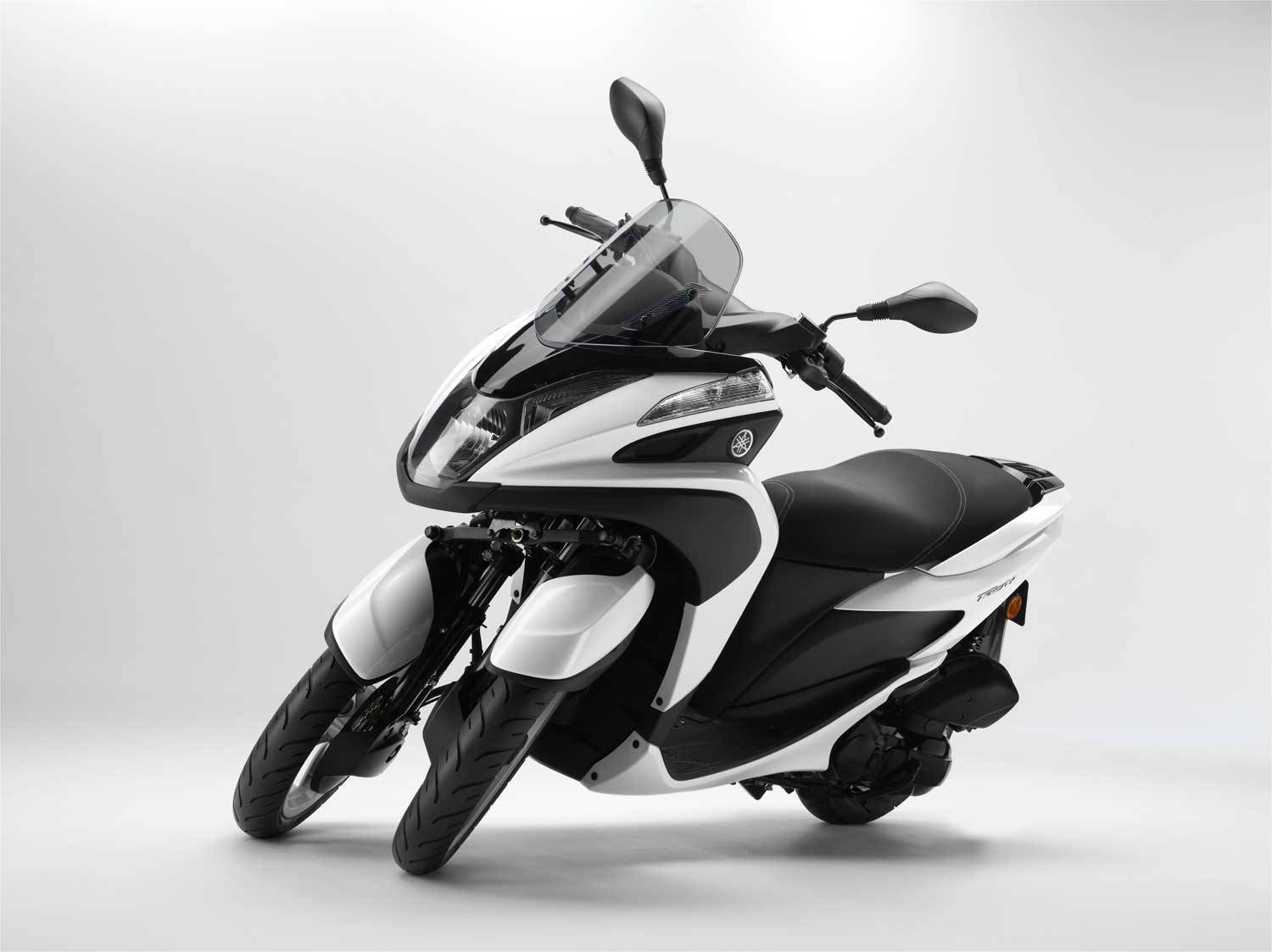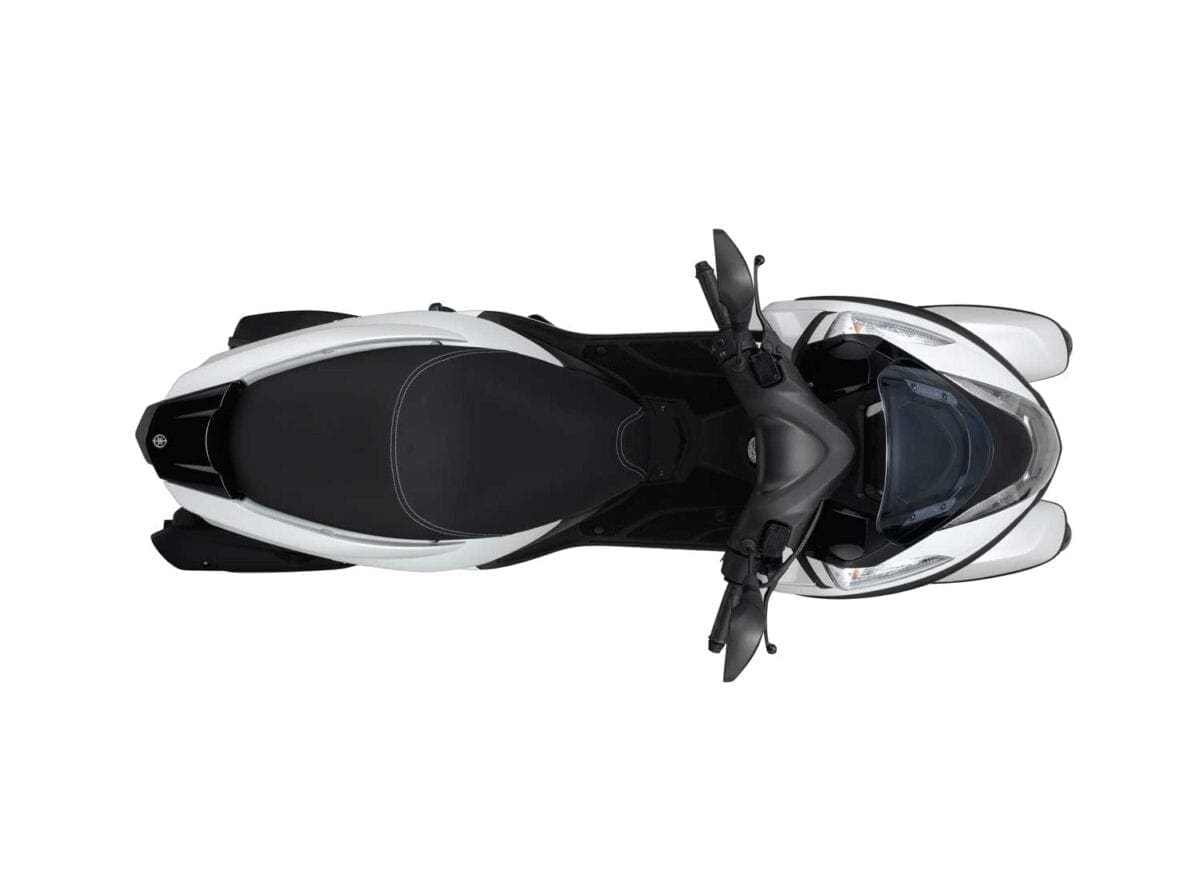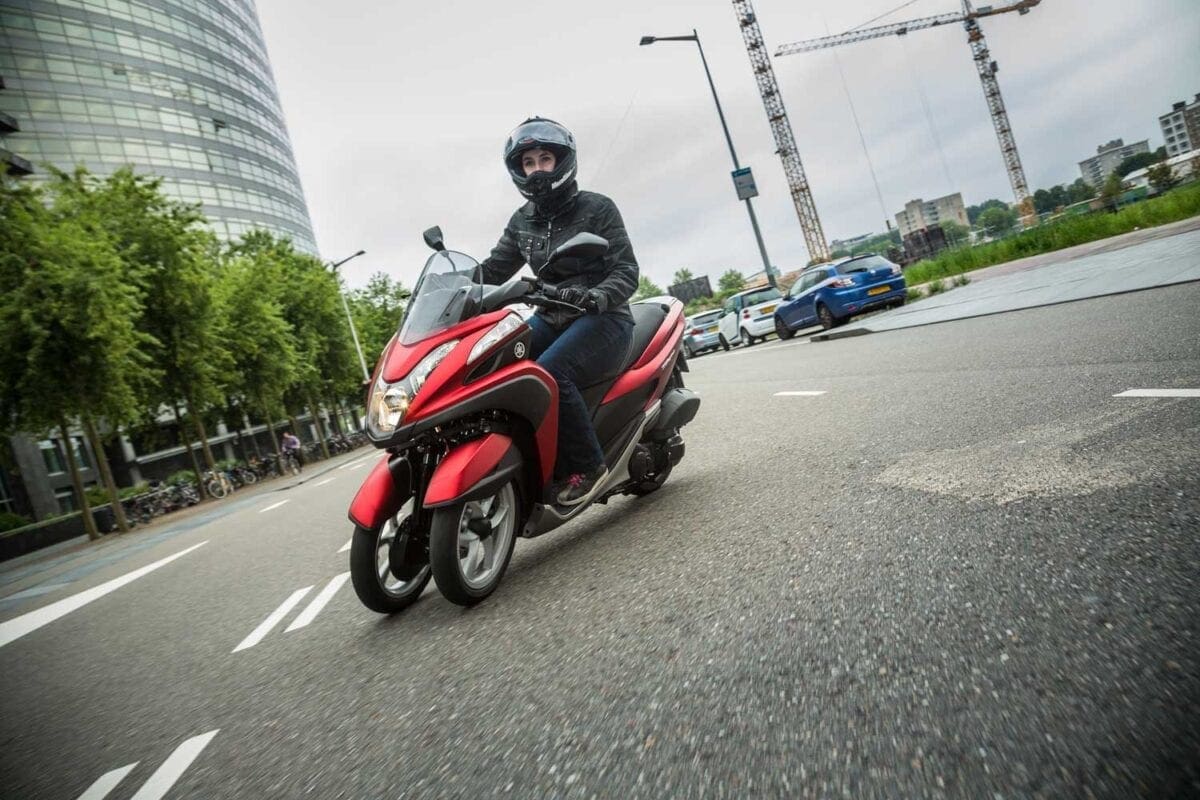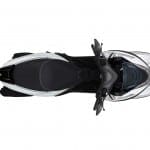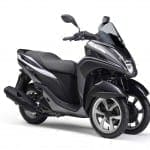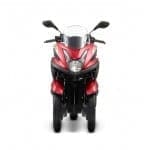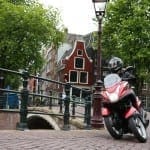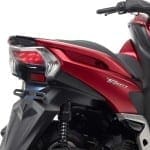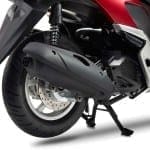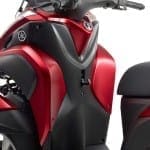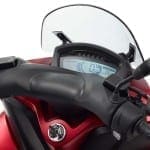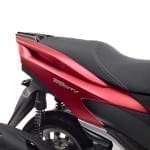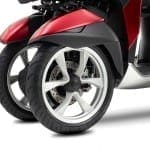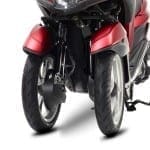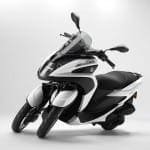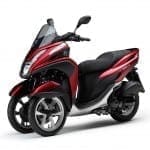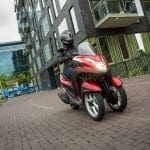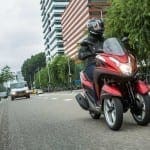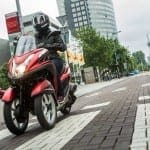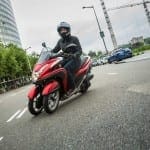£3399 | 10.9bhp@9000rpm | 7.7lb-ft@5500rpm | 124.8cc liquid-cooled, 4-stroke
Tested by: Carli Ann Smith Photos: Yamaha
The brand new Yamaha Tricity is an A1 motorcycle licence compliant three wheeled scooter, and the first in the ‘New Mobility’ segment for the Japanese manufacturer. With the aim to encourage more people onto two – or in this case, three – wheels, the Tricity offers extra stability, plentiful under seat storage and a new alternative for riders.
Tell me about the engine
 Whilst it might not be a new engine for Yamaha, it’s new for the European market. The liquid-cooled, single cylinder lump is meaty for a 125cc, and will see you up to 70mph happily. Power delivery is smooth and there isn’t any jerkiness or lag from the throttle, which gives real confidence whilst riding and performing tight manoeuvres.
Whilst it might not be a new engine for Yamaha, it’s new for the European market. The liquid-cooled, single cylinder lump is meaty for a 125cc, and will see you up to 70mph happily. Power delivery is smooth and there isn’t any jerkiness or lag from the throttle, which gives real confidence whilst riding and performing tight manoeuvres.
Acceleration is prompt and the scooter features YMJET-FI – Yamaha’s Mixture Jet-Fuel Injection – a system which tailors the needs of the engine, apparently saving fuel and keeping emissions low.
The four-stroke motor drives a V-belt instead of a chain: working on the same principal as a chain drive, it has a number of advantages including less maintenance and a smoother ride. The belt needs changing every 12,000 miles, so that’s plenty of care-free scooting time – perfect for new riders who may not want to be lubing and adjusting chains at a weekend.
What’s the chassis like?
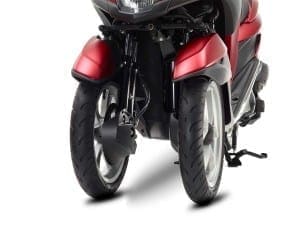 Yamaha have developed a brand new lightweight chassis to compensate for the extra weight of the third wheel on the front.
Yamaha have developed a brand new lightweight chassis to compensate for the extra weight of the third wheel on the front.
The parallelogram link – two pieces of aluminium – pivot to allow the wheels to move and lean. It’s ‘Quite a primitive mechanism’, says Yamaha, but it’s been refined to ensure it moves as the rider expects. These links work in conjunction with the cantilevered telescopic suspension, effectively using four fork legs. Each of the four tubes have 90mm of travel, so curb stones can be tackled easily and ridden over while the scooter remains level. The two front tubes act as guides, while the 33mm pair to the rear of each wheel provide the shock absorption. The result? Great suspension which takes care of cobblestones as well as larger holes.
Riding over a manhole cover in the middle of the road is no problem – each wheel can move up and down independently and compensate for the difference in height, making for a very smooth ride.
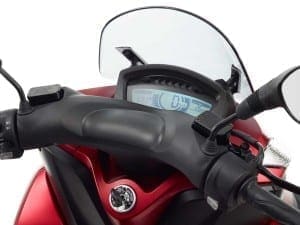 A ‘Unified Braking System’ is fitted on the Tricity, with disc brakes on both front wheels and on the rear. Press the front brake and just the front brakes engage. For a more instant response, by pressing the back brake (left lever), both the rear and the front brakes are engaged. By squeezing both levers, the pressure is increased and stopping power is even stronger. Having ridden other machines with linked brakes, you can sometimes feel the system working, and the brake levers can feel slightly wooden, however on the Tricity, there was good feedback and braking still felt natural and confidence inspiring.
A ‘Unified Braking System’ is fitted on the Tricity, with disc brakes on both front wheels and on the rear. Press the front brake and just the front brakes engage. For a more instant response, by pressing the back brake (left lever), both the rear and the front brakes are engaged. By squeezing both levers, the pressure is increased and stopping power is even stronger. Having ridden other machines with linked brakes, you can sometimes feel the system working, and the brake levers can feel slightly wooden, however on the Tricity, there was good feedback and braking still felt natural and confidence inspiring.
Unlike on the Peugeot Metropolis and the Piaggio MP3, the wheels don’t lock when stationary and the Tricity can fall over so features a side and centre stand. Yamaha has kept the scooter light with a kerb weight of 152kg, so combined with the free-floating wheels, it’s easy to manhandle and move around.
Project Leader on the machine is Kazuhisa Takano – he previously worked on Dakar machines, the YZF500 and Rossi’s YZR-M1. His race bike experience has heavily influenced the weight distribution Tricity: 50:50, the same as a MotoGP bike. The 6.6 litre fuel tank has been moved to under the seat so that whether it’s full or empty, stability is consistent and the distribution ratio is maintained.
Should I buy one?
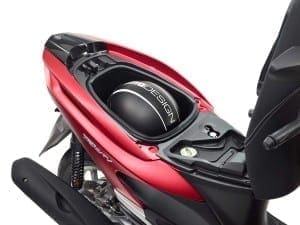 If you’re a new rider or an experienced biker looking for a commuting machine, the Tricity could be a very good choice for you… Our test route took in a variety of roads, including dual carriageways and inner city riding over 50 miles, yet my Tricity delivered 70mpg. With smoother and more consciously economic riding it should be much more.
If you’re a new rider or an experienced biker looking for a commuting machine, the Tricity could be a very good choice for you… Our test route took in a variety of roads, including dual carriageways and inner city riding over 50 miles, yet my Tricity delivered 70mpg. With smoother and more consciously economic riding it should be much more.
Yamaha made the suggestion that they saw it as a family machine – something to be used for work during the week that teenagers could borrow on weekends, or a solution for a parent doing the school run. I really like this idea and think that this type of vehicle could be a way to show just some of the benefits of two-wheels.
At 125cc, it’s a friendly machine, but has enough power to keep up with traffic and get you to your destination quickly. Unlike some other three-wheeled scooters, it can’t be ridden on a car licence because it’s front wheels are too close together (which helps keeps it narrow).
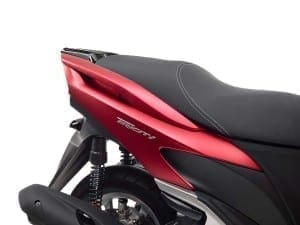 The spacious pillion seat, substantial footpegs and secure grab rail mean that passengers will have a comfortable ride, while it has 20 litres of storage under the seat (fitting in a full face helmet). It’s perfect for a rainsuit and some overnight gear, or a few groceries on the way home from work. There’s a foldaway carry hook on the front too.
The spacious pillion seat, substantial footpegs and secure grab rail mean that passengers will have a comfortable ride, while it has 20 litres of storage under the seat (fitting in a full face helmet). It’s perfect for a rainsuit and some overnight gear, or a few groceries on the way home from work. There’s a foldaway carry hook on the front too.
The extra wheel appeals to those who may be hesitant to ride – Yamaha were quick to point out that it wasn’t made for long distances, but I feel they’re being hard on themselves… The seat is comfortable and the ride is smooth – I’d be happy to tackle my 70 mile daily commute on it.
It first service is at 600 miles and then every 2400 miles after. And because the suspension is telescopic, dealers are well equipped and knowledgeable when dealing with it.
There are a range of accessories available to customise the scooter, including a 39 litre top case, high windscreen, heated handgrips, GPS holder, hand protection, console bag, sports screen and aluminium footplates.
So what’s it like to ride?
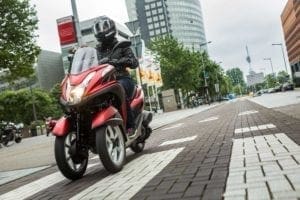 Whizzing round Amsterdam town centre, the Tricity handled the different and challenging road surfaces with ease. Its narrow front wheels help it turn on a sixpence, and tight low-speed corners are a breeze. I was doing smooth U-turns within minutes of being on the machine, and navigating my way up steep curbs with confidence.
Whizzing round Amsterdam town centre, the Tricity handled the different and challenging road surfaces with ease. Its narrow front wheels help it turn on a sixpence, and tight low-speed corners are a breeze. I was doing smooth U-turns within minutes of being on the machine, and navigating my way up steep curbs with confidence.
The extra wheel compensates for a multitude of road defects – manhole covers, pot holes, uneven road surfaces and steep cambers. And of course, in the rain, it felt stable and well grounded.
The dash offers speed, time, fuel gauge and outside temperature. There’s also an odometer, two trip meters, an oil trip and belt trip to ensure you know when your next service is due.
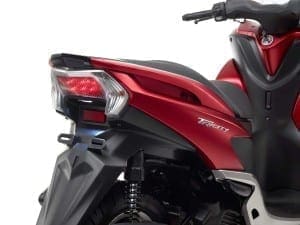 I found the riding position comfortable and the seat was well padded and cushioned for comfort. There’s plenty of room for my legs and I could put my feet down easily on the floor. Other’s riding the scooter were taller than me, but still found plenty of leg room.
I found the riding position comfortable and the seat was well padded and cushioned for comfort. There’s plenty of room for my legs and I could put my feet down easily on the floor. Other’s riding the scooter were taller than me, but still found plenty of leg room.
Filtering’s easy as the wheels aren’t wider than the handlebars, which makes it easy to gauge how much room you need to get through a gap or in-between cars, plus it’s no wider at the bars than some other scooters on the market.
The 14” front wheels offer big wheel stability with small wheel agility. It’s also the only 125cc three-wheeler on the market: Piaggio’s MP3 was available as a 125 and 250 back in 2006 and 2007 but only the 300cc and 500cc versions are now available. You could pick those up second-hand but I don’t think that someone in the market for an MP3 or a Peugeot Metropolis would be looking at the Tricity thanks to the weight and price differences. With over 150,000 MP3s sold in Europe, there’s
certainly a market for these new-fangled three-wheeled scooters, and Yamaha’s machine will hopefully see a lot more of them on the UK roads, bringing more people into the biking life.
TECH SPEC
Price: £3399
Engine: Single cylinder, liquid-cooled, 4-stroke
Power: 10.9bhp (8.1kW) @ 9000rpm
Torque: 7.7lb-ft (10.4Nm) @ 5500rpm
Kerb Weight: 152kg
Seat height: 780mm
Tank size: 6.6 litres


